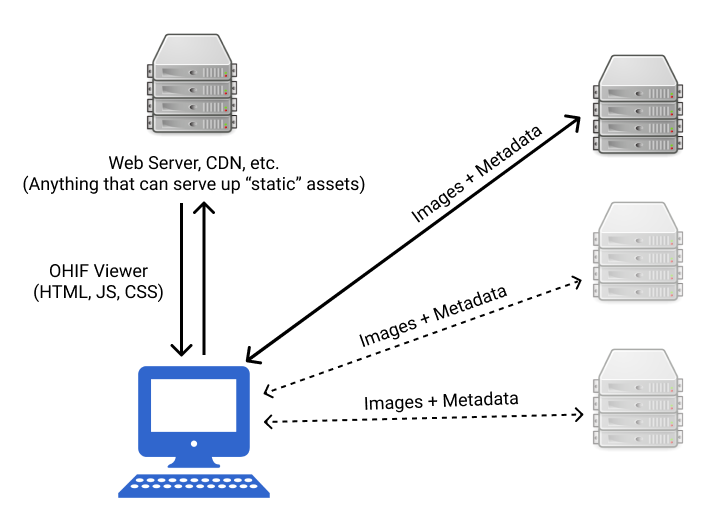Scope of Project
The OHIF Viewer is a web based medical imaging viewer. This allows it to be used on almost any device, anywhere. The OHIF Viewer is what is commonly referred to as a "Dumb Client"
A dumb client is software that fully depends on a connection to a server or cloud service for its functionality. Without a network connection, the software offers nothing useful. - simplicable.com
While the Viewer persists some data, it's scope is limited to caching things like user preferences and previous query parameters. Because of this, the Viewer has been built to be highly configurable to work with almost any web accessible data source.

To be more specific, the OHIF Viewer is a collection of HTML, JS, and CSS files. These can be delivered to your end users however you would like:
- From the local network
- From a remote web server
- From a CDN (content delivery network)
- From a service-worker's cache
- etc.
These "static asset" files are referred to collectively as a "Progressive Web Application" (PWA), and have the same capabilities and limitations that all PWAs have.
All studies, series, images, imageframes, metadata, and the images themselves must come from an external source. There are many, many ways to provide this information, the OHIF Viewer's scope DOES NOT encompass providing any data; only the configuration necessary to interface with one or more of these many data sources. The OHIF Viewer's scope DOES include configuration and support for services that are protected with OpenID-Connect.
In an effort to aid our users and contributors, we attempt to provide several deployment and hosting recipes as potential starting points. These are not meant to be rock solid, production ready, solutions; like most recipes, they should be augmented to best fit you and your organization's taste, preferences, etc.
FAQ
Am I able to cache studies for offline viewing?
Not currently. A web page's offline cache capabilities are limited and somewhat volatile (mostly imposed at the browser vendor level). For more robust offline caching, you may want to consider a server on the local network, or packaging the OHIF Viewer as a desktop application.
Does the OHIF Viewer work with the local filesystem?
It is possible to accomplish this through extensions; however, for a user experience that accommodates a large number of studies, you would likely need to package the OHIF Viewer as an Electron app.